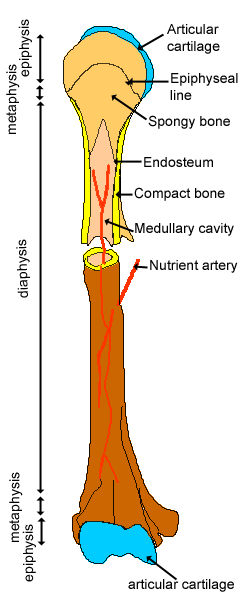Cartilage, Bone & Ossification: Bone
What is bone for?
- Support - bones make up a structural framework for the body, and provide attachment sites for muscles.
- Protection - protection of internal organs - i.e. brain, heart and lungs,
- Assisting movement.
- Mineral homeostasis - the bone is a store for calcium and phosphorus
- Blood cell production - takes place in the bone marrow.
What is bone made up of?
Bone is a strong, flexible and semi-rigid supporting tissue. It can withstand compression forces, and yet it can bend. Like cartilage, and other types of connective tissue, bone is made up of Cells and Extracellular matrix:
Cells - which in bone are called osteoblasts and osteocytes, (osteo - bone). There are also two other cell types: osteoprogenitor cells and osteoclasts.
Find out more about the types of cells found in bone
Extracellular matrix, which is made up of an organic matrix (30%) containing proteoglycans (but less than cartilage), glycosaminoglycans, glycoproteins, osteonectin (anchors bone mineral to collagen) and osteocalcin (calcium binding protein). There are collagen fibres (mostly type I (90%), with some type V). Only 25% of bone is water. Almost 70% of bone is made up of bone mineral called hydroxyapatite.
Before the extracellular matrix is calcified, the tissue is called osteoid (bone-like) tissue. When the concentrations of calcium and phosphate ions rise high enough, they are deposited into the extracellular matrix, and the bone calcifies. Impaired calcification (i.e. in diseases such as rickets) leads to higher levels of osteoid tissue than normal. Calcification occurs only in presence of collagen fibres - salts crystallize in the spaces between the fibres, then accumulate around them.
Bone is resistant to bending, twisting, compression and stretch. It is hard, because it is calcified, and the collagen fibres help the bone to resist tensile stresses. If you dissolve away the calcium salts of bone, then the bone becomes rubbery because of the collagen fibres which are left behind.
Types of bone:

The first bone formed at any site is woven (or primary) bone, but this is soon replaced by lamellar bone. In woven bone the collagen fibres are random. In lamellar bone, the collagen fibres have become re-modelled to become more parallel - in layers.
There are two types of mature bone:
1. Compact - which is found in the shafts of long bones (in the diaphyses). This makes up 80% of all bone.
2. Spongy (cancellous) bone - which is found at the ends of long bones (in the epiphysis). This makes up 20% of all bone. This type of bone contains red bone marrow and a network of bony trabeculae.
A 'periosteum' is found on the outside of bone. This is a dense fibrous layer, where muscles insert. It contains bone forming cells. It is not found in the regions of bone covered by articular cartilage.
The endosteum is the name given to the tissue that lines the inner surfaces of bones.
Click here to find out about the structure of these two types of bone in more detail.
(Note : osteo - bone from the greek osteon which means bone)
Growth and nourishment of bone.
Unlike cartilage, bone has a very good blood supply. Bone is riddled with blood capillaries. The central cavity contains blood vessels and is a storage for bone marrow. All of the osteocytes in bone are within 0.2mm of a capillary. The tissue fluid from the capillary reaches the osteocytes though canaliculi.
There are two ways in which bone can grow:
- Endochondral - formation of bone onto a temporary cartilage model or scaffold.
- Intramembranous - formation of bone directly onto fibrous connective tissue. There is no intermediate cartilage stage. This type of ossification occurs in a few specialised places such as the flat bones of skull (i.e. parietal bone), mandible, maxilla and clavicles. Mesenchyme cells differentiate into osteoprogenitor cells, then into osteoblasts, which secrete the bone matrix. Once the osteoblasts are embedded in the bone matrix, they are known as osteocytes.
Find out more about Ossification
What next ..
When you've finished reading through the sections on bone and cartilage, try drawing up a table comparing the properties of bone, and cartilage:
Think about:
- why bone is able to resist tension and compression.
- How the differences between bone and cartilage can be accounted for in terms of the nature of the extracellular components present in cartilage and bone.
- How bone and cartilage obtain their nourishment.
- The different names for the cells in bone and cartilage.
- The different names for the outer layer of dense connective tissue.